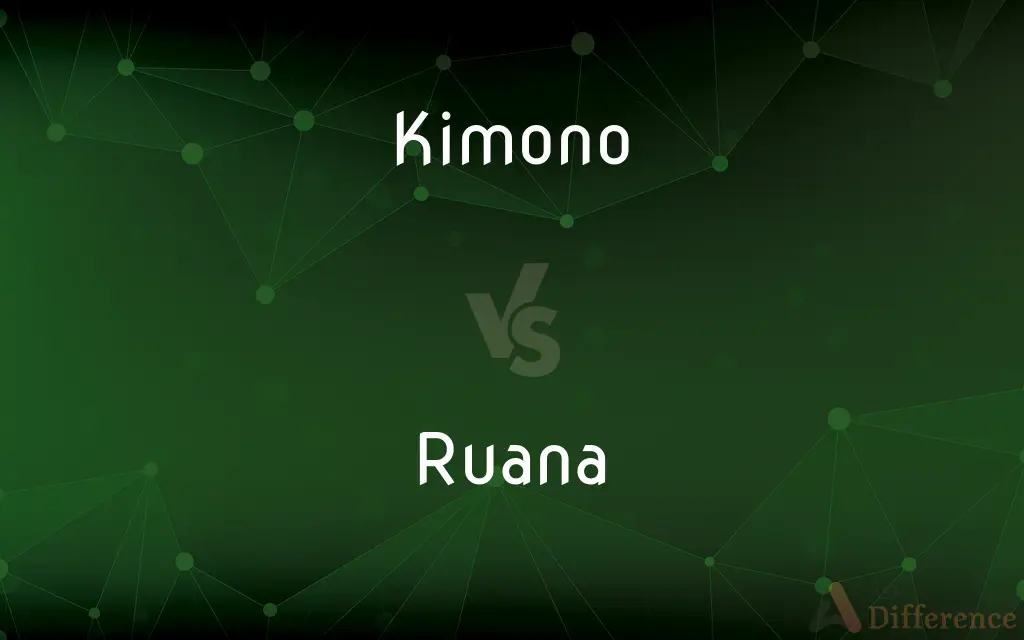Kimono vs. Ruana — What's the Difference?
By Fiza Rafique & Maham Liaqat — Updated on May 2, 2024
A kimono is a traditional Japanese garment with a T-shape, tied with an obi belt, while a ruana is a South American poncho-style wrap, often worn open.

Difference Between Kimono and Ruana
Table of Contents
ADVERTISEMENT
Key Differences
Kimono is a traditional Japanese garment known for its T-shape, straight seams, and long sleeves, often worn for formal occasions and cultural ceremonies. Ruana, originating from the Andes regions of Venezuela and Colombia, is a poncho-style wrap, simpler in its design and used for both practical warmth and casual wear.
Kimono fabrics are usually silk, adorned with intricate patterns and symbols that hold cultural significance, making them artifacts of craftsmanship and tradition. Ruana is typically made from wool or synthetic blends, focusing more on comfort and warmth rather than symbolic content.
Kimonos are worn wrapped around the body, left side over right, secured by a wide belt known as an obi, which itself can be a focal point of aesthetic and technique. Ruana, on the other hand, is draped over the shoulders without the need for fastening, offering a more relaxed and accessible garment.
**In Japan, kimonos are often associated with specific rituals and status, worn by both men and women at festivals, weddings, and other formal occasions. Ruanas are common in daily life in the Andean regions, reflecting a blend of indigenous and modern fashion influences.
Kimono often requires specific knowledge and accessories for proper wearing, including undergarments and footwear, reflecting its ceremonial roots. Ruana is versatile and can be paired easily with everyday clothes, making it a popular choice for chilly days in varied settings.
ADVERTISEMENT
Comparison Chart
Origin
Japan
Andes region of Venezuela and Colombia
Material
Silk, often with elaborate embroidery
Wool, synthetic fibers
Wear Style
Wrapped and tied with an obi belt
Draped openly over the shoulders
Cultural Significance
Worn at formal ceremonies and has symbolic designs
Everyday wear with some cultural significance
Accessories
Requires various accessories for proper wearing
None required, very minimalistic
Compare with Definitions
Kimono
Worn with an obi belt.
Tying the obi belt of a kimono requires skill and practice.
Ruana
South American wrap garment.
She wrapped a colorful ruana around her shoulders to keep warm.
Kimono
Ceremonial attire with deep cultural roots.
Each pattern on the kimono has a symbolic meaning.
Ruana
Worn loosely over the shoulders.
He threw on a ruana quickly to go outside.
Kimono
Made from luxurious fabrics like silk.
The silk kimono shimmered under the festival lights.
Ruana
Part of everyday attire in Andean culture.
Ruanas are common sights in the rural regions of Colombia.
Kimono
Associated with specific traditional events.
He chose a formal kimono for his wedding day.
Ruana
Requires no fastening.
A ruana is convenient because it doesn't need to be tied or buttoned.
Kimono
Traditional Japanese robe.
She wore a vibrant red kimono to the tea ceremony.
Ruana
Often made from wool.
The wool ruana was perfect for the cold mountain weather.
Kimono
The kimono (きもの/着物, lit., "thing to wear" – from the verb "to wear (on the shoulders)" (着, ki), and the noun "thing" (物, mono)) is a traditional Japanese garment and the national dress of Japan. The kimono is a T-shaped, wrapped-front garment with square sleeves and a rectangular body, and is worn left side wrapped over right, unless the wearer is deceased.
Ruana
A ruana (possibly from Spanish ruana "ragged" or Quechua ruana "textile") is a poncho-style outer garment native to the Colombian Andes. In Colombia, the ruana is the characteristic and traditional garment of the department of Boyacá, initially made by indigenous and mestizo people, although it is also made in the departments of Cundinamarca, Antioquia, Nariño, Bogotá, Santander (Colombia), Norte de Santander and Caldas.
Kimono
A long, wide-sleeved Japanese robe worn with an obi and often elaborately decorated.
Ruana
A poncholike garment, open in front, often worn as a wrap.
Kimono
A loose, light robe worn chiefly by women.
Ruana
A poncho.
Kimono
A traditional Japanese T-shaped, wrapped-front garment with square sleeves and a rectangular body, now generally worn only on formal occasions.
Ruana
An outer garment typical of the Andes region of Venezuela and Colombia, and resembling a poncho.
Kimono
(loosely) A yukata.
Kimono
A long robe-like garment in Western fashion, which may be open at the front, loosely inspired by the Japanese garment.
Kimono
(regional) A bathrobe or dressing gown.
Kimono
A kind of loose robe or gown tied with a sash, worn as a traditional outer garment by Japanese women and men. Women may wear it with a broad sash called an obi, having a large bow in the back. At present (1998), most Japanese wear it only at home or on ceremonial occasions, western-style clothing being more common in the workplace.
Kimono
A similar gown worn as a dressing gown by women of Western nations.
Kimono
A loose robe; imitated from robes originally worn by Japanese
Common Curiosities
How is a kimono worn?
A kimono is wrapped around the body, with the left side over the right, and tied securely with an obi belt.
What is a ruana?
A ruana is a poncho-style wrap from the Andes region, usually made of wool, and worn draped over the shoulders.
What accessories are typically worn with a kimono?
Accessories can include an obi belt, zori sandals, and sometimes a nagajuban undergarment.
What are the cultural significances of a ruana?
Ruanas reflect indigenous and local traditions, often embracing practicality and simplicity.
What is a kimono?
A traditional Japanese garment, typically made of silk, characterized by its T-shape and elaborate designs.
Is a ruana used for special occasions?
While ruanas can be used for daily wear, they can also be part of festive attire in the Andean regions.
Are kimonos suitable for all weather conditions?
Kimonos are more suitable for moderate to cool weather due to their materials and layering.
Can a kimono be worn casually?
Traditionally, kimonos are not casual wear, but modern variations and yukatas are more casual.
How long does it take to put on a kimono?
Dressing in a traditional kimono can take considerable time and skill, often requiring assistance.
How do you clean a ruana?
Ruanas made of wool should be either washed gently by hand or dry cleaned, depending on the care instructions.
Share Your Discovery

Previous Comparison
Elitism vs. Pluralism
Next Comparison
Almost vs. PracticallyAuthor Spotlight
Written by
Fiza RafiqueFiza Rafique is a skilled content writer at AskDifference.com, where she meticulously refines and enhances written pieces. Drawing from her vast editorial expertise, Fiza ensures clarity, accuracy, and precision in every article. Passionate about language, she continually seeks to elevate the quality of content for readers worldwide.
Co-written by
Maham Liaqat















































